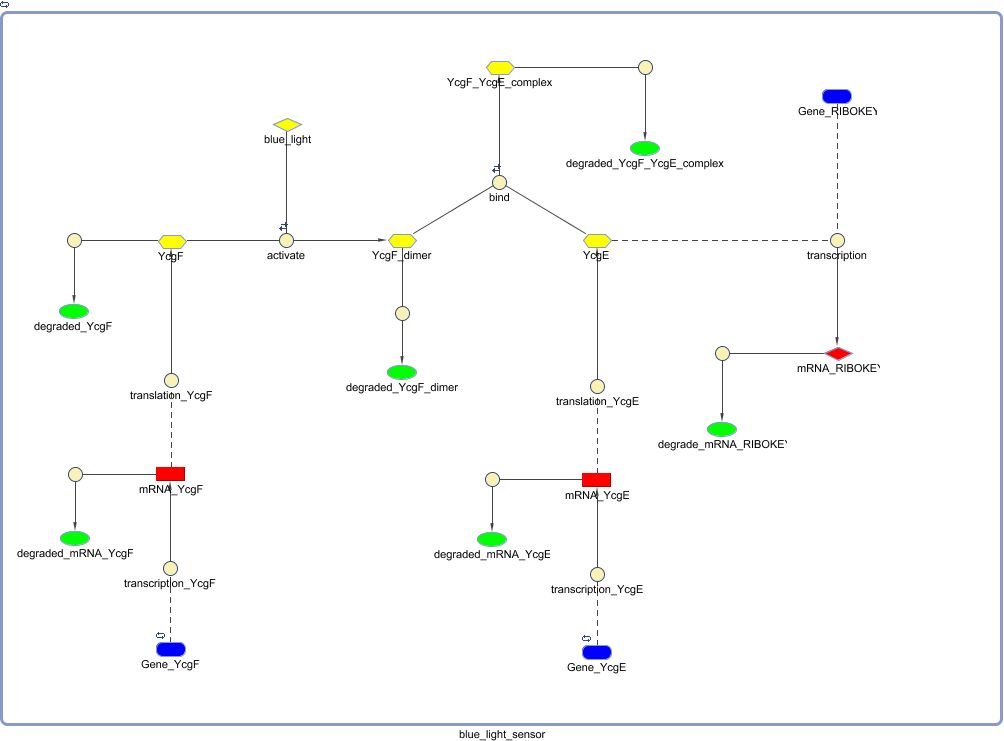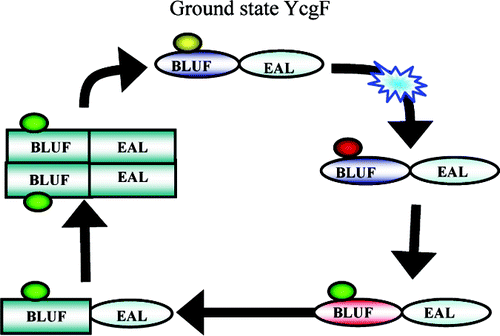Team:KULeuven/Modelling/Blue Light Receptor
From 2009.igem.org
Bart Bosmans (Talk | contribs) |
Bart Bosmans (Talk | contribs) |
||
| (3 intermediate revisions not shown) | |||
| Line 7: | Line 7: | ||
==Overview== | ==Overview== | ||
| - | The purpose of the sensor is to | + | The purpose of the sensor is to enter the wanted vanillin concentration. Under the influence of the intensity of a blue light, the RIBOKEY is transcribed. The light used to perform the test has a wavelength of 470nm. |
| - | The biology works as follows | + | The biology works as follows: |
| - | The YcgE protein | + | |
| - | interacting with the operator-bound YcgE, | + | YcgF protein is believed to dimerize upon photo-excitation. The YcgE protein functions as a repressor for the transcription of the mRNA_RIBOKEY. However, the dimer form of YcgF is capable of interacting with the operator-bound YcgE, thereby releasing it from the DNA and starting transcription. |
[[Image:Biologie_blue_light.png|center]] | [[Image:Biologie_blue_light.png|center]] | ||
==Models== | ==Models== | ||
The entire network of interactions is visualized in the diagram below | The entire network of interactions is visualized in the diagram below | ||
| - | [[Image: | + | [[Image:Bls.JPG|center|thumb|600px|Regulation of the production of mRNA key by incident blue light]] |
==Reactions== | ==Reactions== | ||
Latest revision as of 14:01, 28 August 2009
Contents |
Blue light Sensor
Overview
The purpose of the sensor is to enter the wanted vanillin concentration. Under the influence of the intensity of a blue light, the RIBOKEY is transcribed. The light used to perform the test has a wavelength of 470nm.
The biology works as follows:
YcgF protein is believed to dimerize upon photo-excitation. The YcgE protein functions as a repressor for the transcription of the mRNA_RIBOKEY. However, the dimer form of YcgF is capable of interacting with the operator-bound YcgE, thereby releasing it from the DNA and starting transcription.
Models
The entire network of interactions is visualized in the diagram below
Reactions
Dimerization of YcgF
"Transient Dimerization and Conformational Change of a BLUF Protein: YcgF", [http://pubs.acs.org/doi/full/10.1021/ja065682q]
"Light Induced Structural Changes of a Full-length Protein and Its BLUF Domain in YcgF(Blrp), a Blue-Light Sensing Protein That Uses FAD (BLUF)" [http://pubs.acs.org/doi/abs/10.1021/bi051820x]
"Influence of a Joining Helix on the BLUF Domain of the YcgF Photoreceptor from Escherichia coli" [http://www3.interscience.wiley.com/cgi-bin/fulltext/121407023/PDFSTART]
YcgF - YcgE interaction
"The BLUF-EAL protein YcgF acts as a direct anti-repressor in a blue-light response of Escherichia coli" [http://genesdev.cshlp.org/content/23/4/522.full.pdf+html]
Transcription of the RIBOKEY
https://2008.igem.org/Team:KULeuven/Model/Filter
Degradation of the RIBOKEY
https://2008.igem.org/Team:KULeuven/Model/Filter
References
[1] Natalia Tschowri, Susan Busse and Regine Hengge, "The BLUF-EAL protein YcgF acts as a direct anti-repressor in a blue-light response of Escherichia coli"
 "
"


